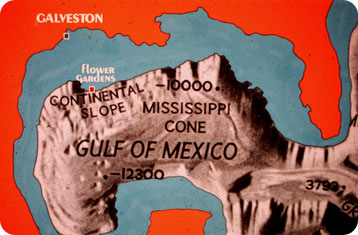Texas may be famous for its beautiful wildflowers, but how many Texans know about the amazing flower gardens hidden off the Texas Coast?
 Gulf of Mexico showing the Flower Gardens Banks. Credit: National Oceanic & Atmospheric Administration.
Gulf of Mexico showing the Flower Gardens Banks. Credit: National Oceanic & Atmospheric Administration.In the Gulf of Mexico about 110 miles south of the Texas-Louisiana border lay the Flower Garden Banks, the northernmost coral reefs in the United States. Named for their brightly colored plant and animal life, these underwater communities have a unique geological past.
The coral formations of the Flower Garden Banks are perched atop giant salt domes, called diapirs, which rise from the ocean floor. About 160 million years ago, massive amounts of salt were deposited in the Gulf. When heavier sediments were deposited over the salt, internal pressures on the sea floor began to build, eventually pushing up the salt to form huge domes.
Why are these isolated structures suitable for coral reefs? The salt domes are only about 50 feet below the surface, so they receive sunlight and they are bathed in warm Gulf waters — two conditions corals need to thrive. The nearest coral reefs are about 400 miles away, off the coast of Mexico. Scientists suspect that the biological community living on the Flower Gardens started when young organisms drifted there in currents that came northward from Mexico some 10,000 years ago.
Today, the Flower Garden Banks are a bustling coral reef community, supporting more than 300 species of invertebrates and 175 types of fish, as well as sea turtles, rays, and sharks. The area has even been designated a national marine sanctuary in the hopes that the color and beauty of these gardens will last for years to come.


